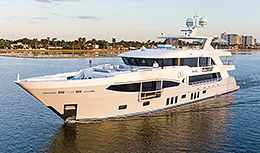- Alaskan Yachts
- Azimut Yachts
- Back Cove Yachts
- Beneteau Yachts
- Benetti Superyachts
- Bertram Yachts
- Boston Whaler
- Broward Yachts
- Buddy Davis Sportfish
- Burger Yachts
- Cabo Yachts
- Catamarans
- Carver Motoryachts
- Center Console
- Chris-Craft Yachts
- Cruisers Yachts
- DeFever Trawlers
- Dufour Sailboats
- Fairline Yachts
- Feadship Yachts
- Ferretti Yachts
- Formula Yachts
- Fountaine Pajot Cats
- Grady-White
- Grand Banks Trawlers
- Hargrave Yachts
- Hatteras Yachts
- Hinckley Picnic Boats
- Horizon Yachts
- Hydra-Sports
- Intrepid Boats
- Jarrett Bay Sportfish
- Jeanneau Yachts
- Kadey-Krogen Trawlers
- Lazzara Yachts
- Lekker Boats
- Luhrs Sportfish
- Marlow Yachts
- Maritimo Yachts
- Marquis Yachts
- Mazu Yachts
- McKinna Motoryachts
- Meridian Yachts
- Midnight Express
- MJM Yachts
- Mochi Craft
- Neptunus Motoryachts
- Nordhavn Trawlers
- Nordic Tugs
- Numarine Yachts
- Ocean Alexander Yachts
- Ocean King
- Offshore Yachts
- Outer Reef
- Oyster Sailing Yachts
- Pacific Mariner Yachts
- Palmer Johnson Yachts
March 30, 2020 4:53 pm
Bertram is back with a powerful, seamlessly built 35-footer that’s a pretty as the sportfishing exemplar that inspired her, the iconic Bertram 31.
This article originally appeared in the July 2017 edition of Power & Motoryacht magazine, written by Captain Bill Pike.
There she was, berthed in the haulout slip at Bertram’s Tampa facility—the new Bertram 35. A bunch of guys were gathered around, some on board, feverishly finishing a washdown; some on a nearby floating dock, burnishing her “Aristo Blue” Awlcraft paint job; and some standing farther off, clearly admiring an assortment of styling elements and architectural details that obviously owed a great deal to the old, super-popular Bertram 31 but, just as obviously, went many nautical miles beyond her.
My sea trial of the 35 had been a long time coming. I’d first laid eyes on the boat in early May of last year, during a press event at Lyman-Morse in Thomaston, Maine. She’d been only semi-finished then, little more than a collection of disembodied components produced by Lyman and laid out for our inspection, awaiting a truck ride south to Tampa, where a passel of Bertram employees would finish the assembly and crank up a production line for all subsequent iterations.
One aspect in particular stood out. While the renderings of the 35 the Bertram folks were passing around showed a finished product that seemed elegantly and classically simple, especially in terms of her profile, the complexity of the fiberglass work necessary to produce this impression was, from what I could see, extreme.
The flybridge illustrated the point best. At first glance it appeared to be a smooth, one-piece, curvaceous construct, but upon closer inspection I saw that it was actually an amalgam of five separate, through-bolted, fiberglass-bonded parts, each finely tooled and crafted to fit unobtrusively and seamlessly into the whole.
Then there was another attention grabber. Because the boat’s hull was wholly open at the time of the event, containing little more than three tanks, a few wiring chases, and a couple of big diesels, the entirety of the hulking, highly elaborate “structural grid” inside was totally visible. Not only did this thing seem to be the very essence of complexity, but, according to Earl Blackwell, Bertram’s engineering guru on the scene, its multidimensional tolerances had been meticulously refined to a fare-thee-well in order to facilitate a perfect chemical bond (via Plexus methacrylate adhesive) with the resin-infused, solid-glass hull bottom and Divinycell-cored hullsides encompassing it.
“We have two things going on here,” Blackwell explained. “First, we’re attempting to evoke the character of the old, original Bertram 31, which was a very, very popular, relatively Spartan, rough- water-capable boat. But at the same time, we’re also trying to meet or exceed the expectations of the modern boat buyer. Heck, decades ago, the old 31 was built using, maybe, eight or nine separate molds. And there were screws and aluminum trim pieces covering seams almost everywhere you looked. Today, we’re using over 60 separate molds to create the 35, and there are no trim pieces at all, simply because the seamless look is what people expect these days.”

Piscatorial Paraphernalia
Most of the guys were dispersing from around the haulout slip at the Tampa plant—our test boat was apparently ready to boogie. And as I drew nigh, I experienced a wave of nostalgia. Over the years, I’ve fished more than a few Bertrams in various parts of the world and this particular boat, which was outfitted in a way that emphasized sportfishing a bit more than some of her more cruise-focused sister- ships, seemed to be just as much a true, aristocratic huntress as any other Bertram battlewagon, although she sported a raft of top-notch amenities in addition to her piscatorial paraphernalia.
Much of the latter complement was standard-issue, explained Bertram’s company captain Mike Schenk as I jumped aboard. The transom door (with separate top gate) was included in the base price, he said, and so were the two ample, removable fishboxes in the cockpit sole (each plumbed with its own macerator pump), the transom livewell with “aquarium view)’ and the matched set of roistering, 507-horsepower Caterpillar C7.1 diesels that snoozed for the moment under a one-piece, express-style engine hatch.
Of course, there were fish-fighting options too, among them the Sanchez Brothers-built welded-aluminum tower/hardtop assembly that was in part secured to our test boat’s side decks, the teak-paved cockpit sole underfoot, and, on the flybridge above us, the three Release Trillion Series chairs at the Palm Beach-style helm station with its cool, single-lever controls with integrated bow thruster buttons.
We ducked into the cabin for a quick look around. Unquestionably, the layout with its offset-queen-equipped en suite stateroom forward and galley with opposed dinette amidships was a shoe-in for comfy overnighting and weekending, a mission that was just one of many that the 35’s Bertram-lovin designer (+Motoryacht columnist) Michael Peters had to accommodate.
The level of fit and finish was tops. Precisely crafted teak-veneered foam panels predominated, along with sweet, solid-wood inlays, and perfectly finished solid-surface countertops. And there was a nod to stylish practicality as well, thanks to easily maintained Amtico flooring, gutsy, Italian-made Seasmart marine hardware, and a large, custom stainless steel sink in the galley.

Everything’s Workable
“Check out the engine room,” Schenk said, just before hitting a cockpit switch that began electro-hydraulically raising the engine hatch. In a mere moment or two, we were looking into what appeared to be an ever-so-solidly engineered, if decidedly cramped, machinery space.
On the solid side, I was gratified to see mainstream Delta T demisters flanking the CATs, port and starboard, as well as a network of precisely loomed electrics on the forward firewall, two crash pumps in the bilge, and a couple of high-end DeAngelo exhaust risers snaking back into Centek mufflers with surge tubes to obviate flooding out the mains during sporty backdowns.
But on the cramped side? The presence of both an optional, 790-pound SeaKeeper 5 and a fairly large Fischer Panda 7 Mini genset between the two big diesels did not exactly make for oodles and oodles of elbowroom.
As I was eyeballing a set of duplex Racor 500s installed just inches beneath the deck molding abaft the port engine, pondering whether the seeming lack of overhead clearance might complicate filter element changes, a blast from the past arrived—Blackwell, the engineering guru I’d talked to extensively up in Maine.
“I know—the engine room’s tight,” Blackwell acknowledged. “But you’ll find that there’s just enough room above that canister to pull an old element out and install a new one. Tolerances are close in here, but everything’s workable.”

Crazy Pike! Crazy Pike!
My sea trial of the 35 that day generated a mixed performance. For starters, the boat evinced excellent directionality and speed when we simulated a fish-fighting backdown in open water. And hey, not a drop of water came over the transom at a full 5 knots.
And then, toward the end of the festivities, the 35 turned out to be an absolute ball to handle dockside. Indeed, I can’t remember when I’ve enjoyed maneuvering a twin-engine, straight-shaft inboard vessel more. And she was easy, too. Backing her into the haulout slip in a 10- to 15-knot crosswind was a snap, mostly thanks, I’d say, to a massive power-to-weight ratio, superb sight- lines, and a set of perfectly detented single-lever engine controls.
There was an issue, however. During the open-water portion of the trial, at 2200 rpm and above, the 35 would not turn even fairly tight circles without exhibiting a tendency to stall out and actually slow down. Moreover, the phenomenon occurred unevenly and repetitively, whether I turned to starboard or to port.
Ultimately, both Blackwell and Schenk agreed, the problem could be addressed by “toeing in” the leading edges of the 35’s rudders by half an inch or so. This would prevent air or cavita- tional turbulence (or both) from rendering them problematic at higher speeds.
I returned to Bertram’s Tampa facility some weeks later for a second sea trial, which confirmed the theory. The 35’s high-speed turns seemed entirely normal as far as I could tell and, in fact, the boat stalwartly avoided all squirreliness, even when I forced her into some decidedly wild, high-speed, hard-over turns, sideways to 3- and 4-foot wakes.
“You’re crazy, Bill,” Schenk yelled with considerable glee in the midst of one of these babies. “Crazy Pike! Crazy Pike!”

The average top speed of 36.1 knots I got out of the boat was robust, although a good bit shy of the 40-knot figure Bertram touts in some of its advertising. Moreover, the range numbers I recorded, I’d say, preclude truly far-flung tournaments and cruising destinations. But will such findings deter boat buyers enthralled with the relaunch of a legendary brand’s most iconic model? Probably not.
Once we’d finished with her second sea trial, I took a pass on docking the Bertram 35 a second time, in keeping with a personal policy of mine—never maneuver a boat dockside once she’s become the official property of her owner. But I watched with considerable interest as Schenk slid our 35 effortlessly into the haulout slip and then (just for the fun of it, it seemed) walked her sideways, back and forth, using brief thrusts from the mains, forward and reverse, and an occasional burst from the optional Vetus bow thruster.
“Man oh man,” I observed at length, “she’s a little jewel.”
And she is, not only because of her intricate, albeit beefy build and top-shelf ancillaries, but also because she’s an exceptionally pretty, boaty-looking boat. Although not quite the spittin’ image of her predecessor, the grand old Bertram 31, she’s absolutely worthy of comparison in terms of appearance and performance.
Will Bertram come back from its sad dissolution at the hands of former owners and reassume its exalted status? Heck, given the company’s apparent commitment to getting our sea trial of the Bertram 35 right, I’d say there’s a pretty good chance of it.




![Bertram 35 [Boat Review]](https://cdn.denisonyachtsales.com/wp-content/uploads/2020/03/bertramH.jpg)
![Bertram 35 [Boat Review] Share on Facebook](https://cdn.DenisonYachtSales.com/images/share1.svg)
![Bertram 35 [Boat Review] Share via Email](https://cdn.DenisonYachtSales.com/images/share2.svg)
![Bertram 35 [Boat Review] Share on Twitter](https://cdn.DenisonYachtSales.com/images/share3.svg)


